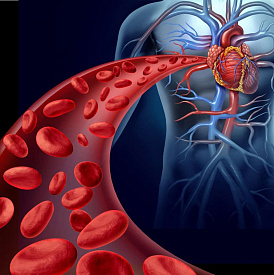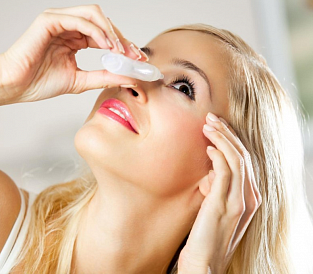8 best drops from cataracts
A cataract is the process of gradual opacification and loss of transparency of the lens tissue, which is normally completely transparent and is considered one of the optical media of the eye. The function of the lens - to work as a lens. That, being reduced, relaxing, it changes its curvature, and helps to focus the exact image on the retina. If a cataract develops, then in the end a person can go blind. Most often, cataracts develop in the elderly, and especially in the presence of diabetes.
Other reasons for the development of the lens opacification process can be: penetrating eye injury, burns by ultraviolet rays, industrial intoxication with mercury and thallium, organic compounds. Quite rarely, a cataract develops as a reaction of the body to receiving large doses of antibiotics and sulfonamides. It contributes to the clouding of the lens and the chronic course of inflammatory diseases of the eye, and especially of uveitis and iridocyclitis.
In its course, a cataract always goes through several stages. At the very beginning, patients note the distortion of the sizes of objects, their contours can be crushed, and the same object can have several. A few years later there is a sharp decrease in visual acuity, and an increase in the lens in volume. This leads to the fact that the anterior chamber of the eye becomes rather shallow. In this state, a cataract can exist for a long time, but when the lens is dehydrated, sooner or later the cataract becomes gray and the vision is already seriously impaired. Patients see only the direction of light, and they do not distinguish objects. At the stage of a mature cataract, the patient sees as if the whole world is covered with glasses with frosted glass. The terminal, or overripe stage, indicates a complete disintegration of the lens, and patients may even incorrectly perceive the direction of light.
Top best cataract drops
| Nomination | a place | Name of product | price |
| Best Drops for Cataract Treatment | 1 | Taufon (Taurine) | 130 ₽ |
| 2 | Oftan Kathrom (adenosine + nicotinamide + cytochrome c) | 410 ₽ | |
| 3 | Quinax (azapentacen) | 400 ₽ | |
| 4 | Emoxipin | 260 ₽ | |
| best drops in the early postoperative period | 1 | Vitabact (picloxidin) | 460 ₽ |
| 2 | Indocoller (indomethacin) | 420 ₽ | |
| 3 | Maksitrol (dexamethasone + neomycin + polymyxin B) | 600 ₽ | |
| 4 | Tobradex (dexamethasone + tobramycin) | 450 ₽ |
Top Cataract Drops
Currently, the "gold standard" in the treatment of cataracts is the surgical method with the installation of an intraocular lens. Treatment of cataracts with the help of drops, tablet preparations, folk remedies is not complete, and can only delay the onset of blindness for a while. However, these methods are successfully used, especially in the early stages, since the process of cataract formation itself is not fast and takes many years.
In the case when the diagnosis of cataract is established in a timely and accurate manner, in the process of preparing for surgical treatment, various drugs, including local drugs, can be used as a compensation in drops.This rating includes the most effective and popular drugs for local use, used at different stages of cataracts, but they are especially shown at the very beginning of the pathological process. Prices are given for pharmacies of all forms of ownership at the beginning of 2019.
Taufon (Taurine)
Rating: 4.9
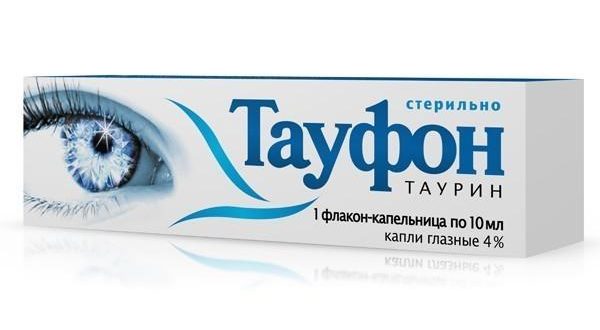
Taufon are famous eye drops that contain taurine. This compound is widely known because even energy drinks containing taurine along with caffeine can be purchased. From a chemical point of view, taurine is an amino acid, the product of cysteine conversion. According to modern data, local application of taurine in ophthalmology improves the processes of eye tissue repair in dystrophic diseases, improves intraocular metabolism, stabilizes cell membranes, and contributes to the improvement of metabolic processes. Thus, Taufon - this metabolic drops that will help slow the development of cataracts, but no more.
Other indications for administration will be various conditions related to non-infectious dystrophic processes in the cornea of the eye, conditions after corneal injuries. Apply Taufon for cataracts should be a long course. In the conjunctiva instilled two drops 3-4 times a day, for 3 months. After that, make a monthly interval, and then repeat the course. Taufon produces domestic Moscow Endocrine Plant, and the drug is inexpensive. For one large bottle of 10 ml you need to pay about 130 rubles.
Advantages and disadvantages
The advantages of Tauphone include good tolerability. It is contraindicated only in case of hypersensitivity, but allergic reactions are extremely rare. This again emphasizes that Taufon is the usual metabolic "energetic" for eye tissue, but it does not have any specific mechanisms of action that help dissolve the already formed clouding inside the lens and eliminate, reverse the cataract process. The only thing that it can delay the time of the occurrence of a significant deterioration in vision. Thus, Taufon is a kind of "food additive" for the eyes.
Oftan Kathrom (adenosine + nicotinamide + cytochrome c)
Rating: 4.8
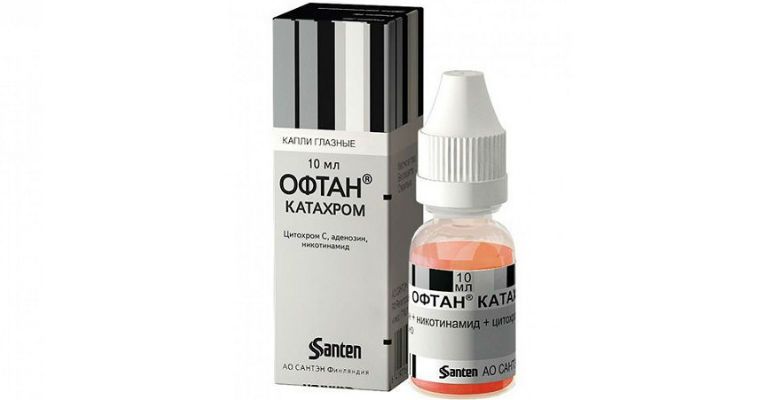
Oftan Katahrom is a more serious drug that is produced by Finnish company Santen. It consists of three components. The first of them, adenosine, is an energy molecule, it is a precursor of adenosine triphosphate, its task is to improve the metabolism inside the eye and, mainly, in the lens. Nicotinamide also stimulates the synthesis of especially reunion, nicotinamide adenine dinucleotide, which regulates metabolic processes and participates in the activity of enzymes dehydrogenases.
Finally, cytochrome C is an important mediator in many redox processes, it has antioxidant activity, and this also slows down the process of loss of transparency by the lens. A cataract is the only official indication for the use of this remedy, and it can be prescribed by dripping into the eyes one or two drops three times a day. The only limitation is that the drug is not indicated for patients who wear soft contact lenses. In order to be able to safely apply these drops in this group of patients, you first need to remove the lenses and put them on 15 minutes after instillation. There is one bottle of these drops in a volume of 10 ml of about 400 rubles.
Advantages and disadvantages
The pros and cons of this drug are exactly the same as those of other metabolic agents used in ophthalmology. There is no data on overdose, there is no interaction with other topical preparations and pills either, and of the side effects there can only be slight intolerance, which consists in short-term tingling and burning. Systemic effects such as pressure drop, nausea, dyspnea are practically not observed.But nicotinamide, or nicotinic acid amide, which is a part, can dilate blood vessels, and in some cases the patient may have a sensation of heat a few minutes after instillation, or even blood pulsation in the temples. In this case, the reception should be stopped, and consult a doctor.
Quinax (azapentacen)
Rating: 4.8
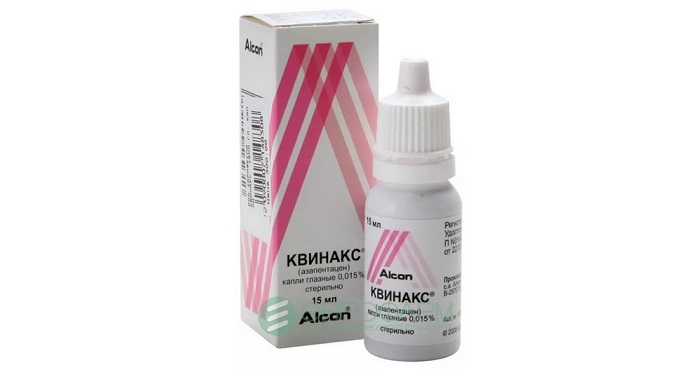
Quinax also refers to metabolic topical preparations, and its main indication for use is the treatment of initial forms of cataracts. The active active ingredient is azapentacen. This is the abbreviated name for sodium polysulphonate dihydroazapentacene. The task of this substance is to activate special enzymes that break down proteins and belong to the class of proteolytic. They are always in the watery moisture that fills the anterior eye chamber. These active enzymes constantly break down various harmful substances that can be deposited on the lens surface in an oxidized state and gradually form opaque complexes.
Therefore, we can consider this drug to clean the surface of our biological lens, and it works like a janitor on automotive glass. It is used in various forms of cataracts, ranging from congenital to senile. Two drops drop it, from 3 to 5 times a day, the course and duration of the reception are determined by the doctor. The Quinax company Alcon produces, and the cost is 400 rubles for 5 ml.
Advantages and disadvantages
Quinax is a successful drug, regarding the mechanism of action and the ability to influence the surface of the lens. But to reduce the turbidity, which occurs not on the surface, but inside the lens itself, it is not able to. In addition, there is convincing evidence that the substance in the composition of the drug is unstable, and with time it collapses, and the effectiveness of the drops decreases. Therefore, at this time in the warehouses of pharmacies of the Russian Federation there are only old stocks. The manufacturing company decided to temporarily suspend the production of these drops, and to increase the stability of the finished chemical compound. Therefore, if you managed to buy these drops, then know that this may be the last time.
Emoxipin
Rating: 4.8
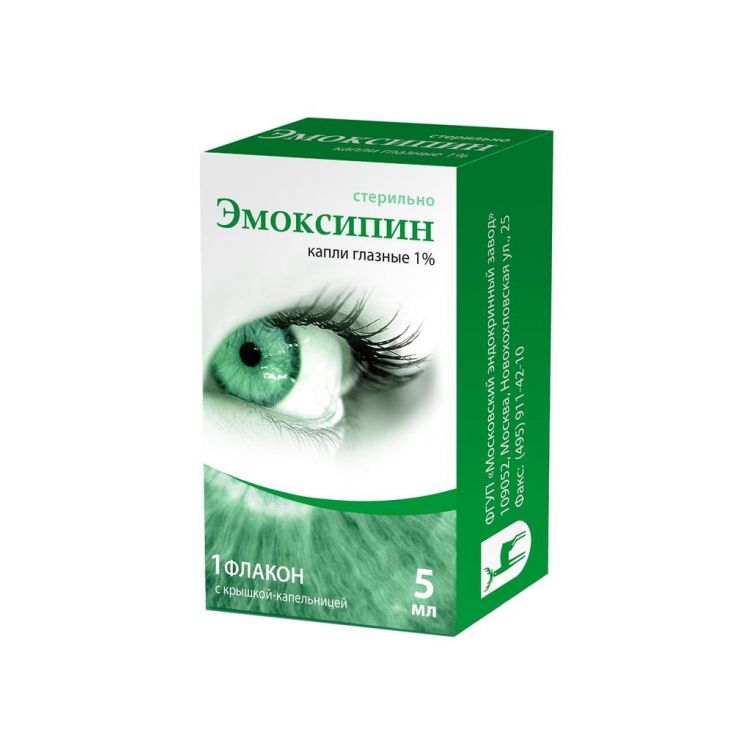
Emoxipin belongs to the group of antioxidant agents. According to modern data, Emoxipin contributes to the stabilization of membranes, strengthens the vascular wall of capillaries, improves the rheological properties of blood, reduces viscosity. With the systematic use of the drug increases the resistance of tissues to chronic hypoxia. After penetrating the tissues of the eye, it breaks down into five different metabolites, which are the products of its transformation and actively influence metabolic processes. In addition to the treatment of cataracts, this tool is actively used in diabetic retinopathy, for the treatment of hemorrhages and corneal inflammatory processes.
The drug is instilled in the usual way three times a day, two drops in each cavity of the conjunctiva, the course of treatment is 1 month. If the patient is well tolerated, the course of treatment may be extended to 6 months. Emoksipin produces domestic pharmaceutical company LLC Firm Enzyme, and the cost of one bottle of 5 ml is 260 rubles.
Advantages and disadvantages
The advantage of Emoxipin is the ability to use it when wearing contact lenses, and this is not a contraindication, the drug protects the cornea. However, as in other cases, Emoxipin alone is not able to prevent the progression of cataracts, and in order to get rid of this disease, surgical intervention is necessary. The drug is well tolerated, allergic reactions rarely develop, sometimes short-term conjunctival hyperemia.
Drops in the early postoperative period
Immediately after the intraocular lens has been inserted into the eye, the ophthalmologist will also prescribe eye drops. Only they serve entirely for other purposes.Their task is to reduce aseptic inflammation, alas, inevitable with surgical intervention. After all, inflammation is a universal reaction of weaving to damage. And for this purpose are products containing both nonsteroidal anti-inflammatory drugs (NSAIDs) and corticosteroid hormones, stronger. Drops with antibiotics are used to prevent bacterial inflammation. Consider the most effective eye drops that are used after cataract removal surgery and the installation of an intraocular lens.
Vitabact (picloxidin)
Rating: 4.9
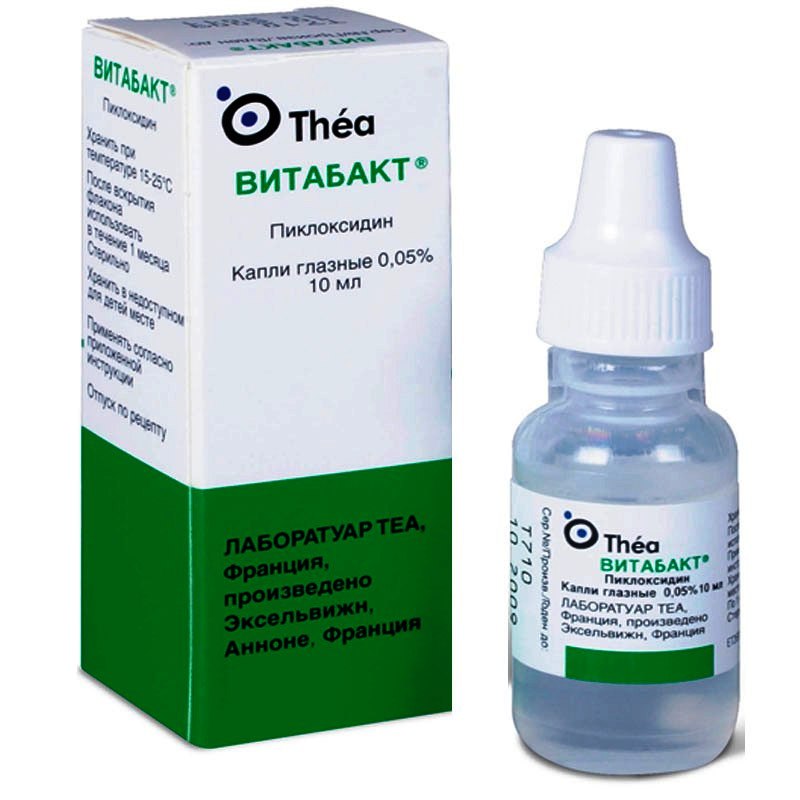
Vitabak drops belong to antiseptics, the active substance in them is at a concentration of 0.05%, it is a clear or slightly yellowish solution. The active ingredient is picloxidine hydrochloride. This remedy is highly active against staphylococci, streptococci, Escherichia coli, Klebsiell, common protea, chlamydia, some fungi and viruses. The use of Vitabact after ophthalmologic operations allows you to prevent the accession of secondary microbial infections and provide good healing and recovery.
In addition to cataract surgery, this remedy is prescribed for various bacterial infections, such as keratitis, conjunctivitis. It is necessary to apply with the preventive purpose, burying in the eye one drop from 3 to 4 times a day. Also shown and instillation of the drug in one or two drops in each conjunctiva immediately before surgery. Vitabak is produced by the French company Excel Vision, and the cost of one 10 ml bottle is, on average, 460 rubles.
Advantages and disadvantages
Vitabact plus will be its pronounced bactericidal activity against many strains of gram-positive and gram-negative microorganisms, fairly good tolerability, as well as activity against many viruses and even fungi. However, it must be remembered that it is strictly necessary to bury it in the conjunctival sac, nor can it have an anti-inflammatory or regenerating effect. Therefore, it still needs to be combined with other drops.
Indocoller (indomethacin)
Rating: 4.8
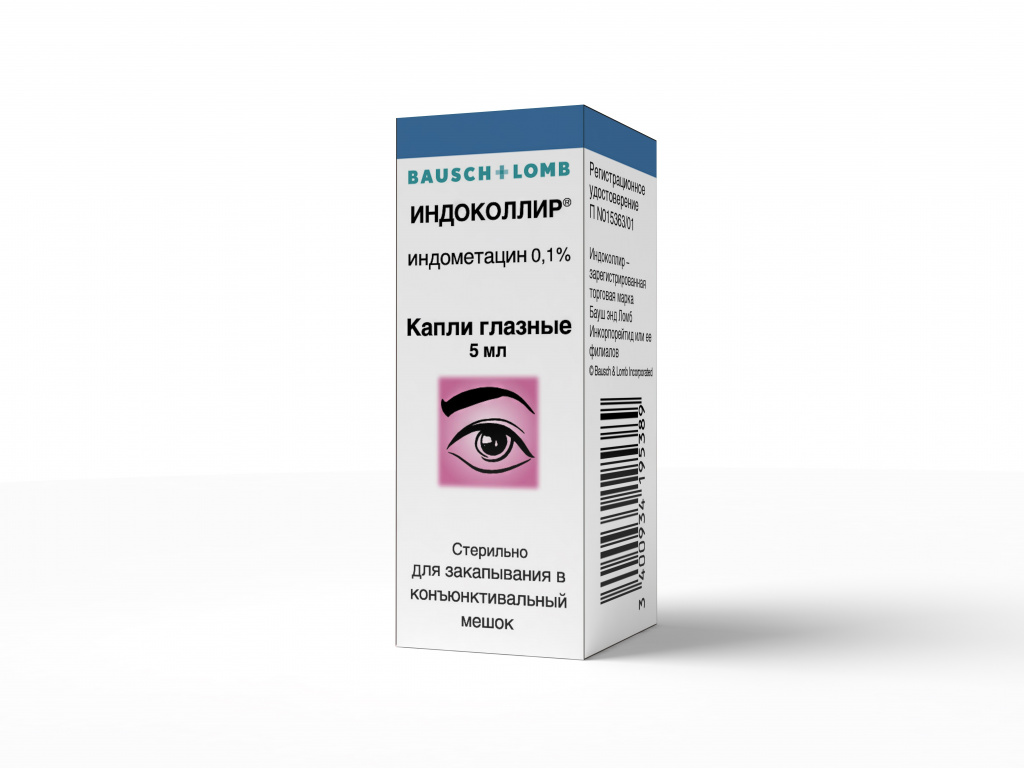
The only active ingredient of these drops is a non-steroidal anti-inflammatory drug, a non-selective inhibitor of cyclooxygenase 1 and type 2 indomethacin. It is well known in tablets called Voltaren, and has a rather high anti-inflammatory and analgesic activity, which is based on the inhibition of prostaglandin synthesis. This tool is shown not only as a drug in the postoperative period to reduce pain and swelling, but also to block miosis, that is, constriction of the pupil during surgery. It is very important that the pupil during the operation is as wide as possible, and then this fact will allow the intraocular lens to be installed quite easily and reliably.
Other indications for use will be the treatment of conjunctivitis of a non-infectious nature, as well as the consequences of eyeball injuries. For the prevention of constriction of the pupil before the operation, the patient is instilled 1 drop in the conjunctiva every 30 minutes for two hours, that is, only 4 times. In the postoperative period, the agent is buried in one drop 3 times a day for a month after surgery. It is worth one bottle of 5 ml of about 420 rubles, and the French pharmaceutical company Chauvin laboratory produces this tool.
Advantages and disadvantages
Indocamelline eye drops containing indomethacin are also slightly “one-sided”. They are well contribute to the prevention of inflammation, postoperative edema, reduce pain. But at the same time they are not able to protect the eye from microbial infection. Therefore, together with them, it is necessary to take other drops that protect the operated eye from the development of pathogenic flora.
Maksitrol (dexamethasone + neomycin + polymyxin B)
Rating: 4.8
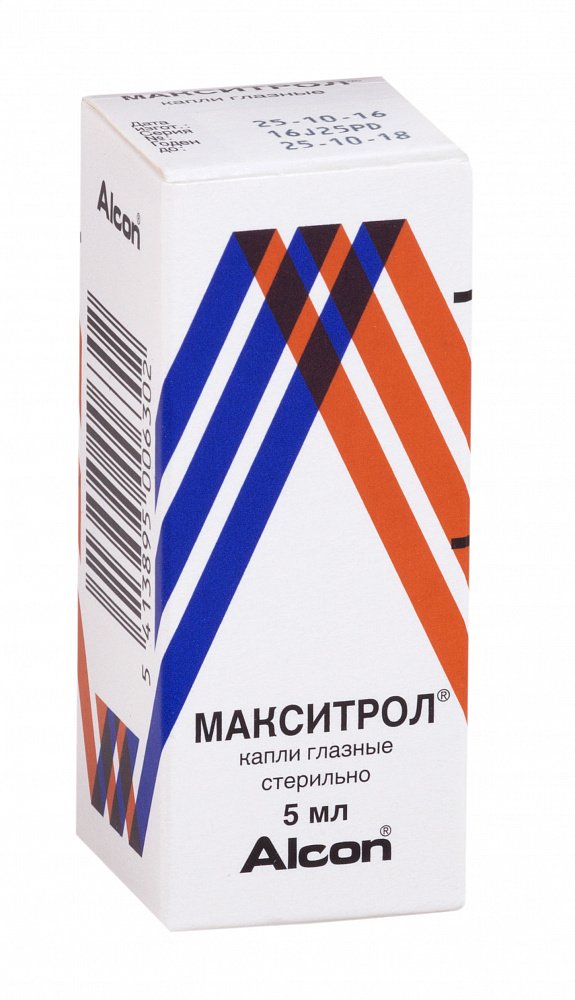
Maxitrol is a combined agent that already contains as many as three components that have a pronounced anti-inflammatory effect due to the glucocorticosteroid hormone dexamethasone, and the antibacterial effect and reliable protection against the development of secondary microbial flora provide antibiotics Polymyxin B and neomycin.
This useful combination allows you to widely use Maxitrol in ophthalmology, and not only for the treatment of cataracts. Two antibiotics have an activating effect on each other, and affect various pathogenic microorganisms. So, if neomycin well destroys staphylococci and streptococci, then polymyxin is active against the pyocyanic stick, Escherichia coli and Klebsiella.
Among the indications for use of Maxitrol, in addition to the postoperative period in any ophthalmologic operations are diseases such as conjunctivitis and keratoconjunctivitis, iridocyclitis, blepharitis, that is, infection of the eye and its auxiliary apparatus. It is necessary to apply Maxitrol, digging into each conjunctival sac after 6 hours, 1 to 2 drops in case of prevention and treatment of a mild infectious process. Pharmaceutical company Alcon produces this drug, and the average cost of one small 5 ml bottle is about 600 rubles, that is, these drops can be considered quite expensive.
Advantages and disadvantages
Maxitrol is a type of combo droplets that are rarely found on sale. The combination of a single agent with a pronounced anti-inflammatory effect under the cover of 2 reliable antibiotics is very effective. But on the other hand, this remedy is quite expensive, and it cannot be used for tuberculous eye damage, as well as for herpetic diseases - ophthalmic herpes. Antibiotics do not have any effect on herpes viruses, and a hormonal drug will suppress immune and inflammatory reactions, and as a result, a complicated herpetic lesion may develop, which may even be complicated by herpetic encephalitis with a high degree of mortality. Therefore, the ideal option is to use this drug for a short course in the postoperative period of cataract removal solely for the purpose of prevention.
Tobradex (dexamethasone + tobramycin)
Rating: 4.7
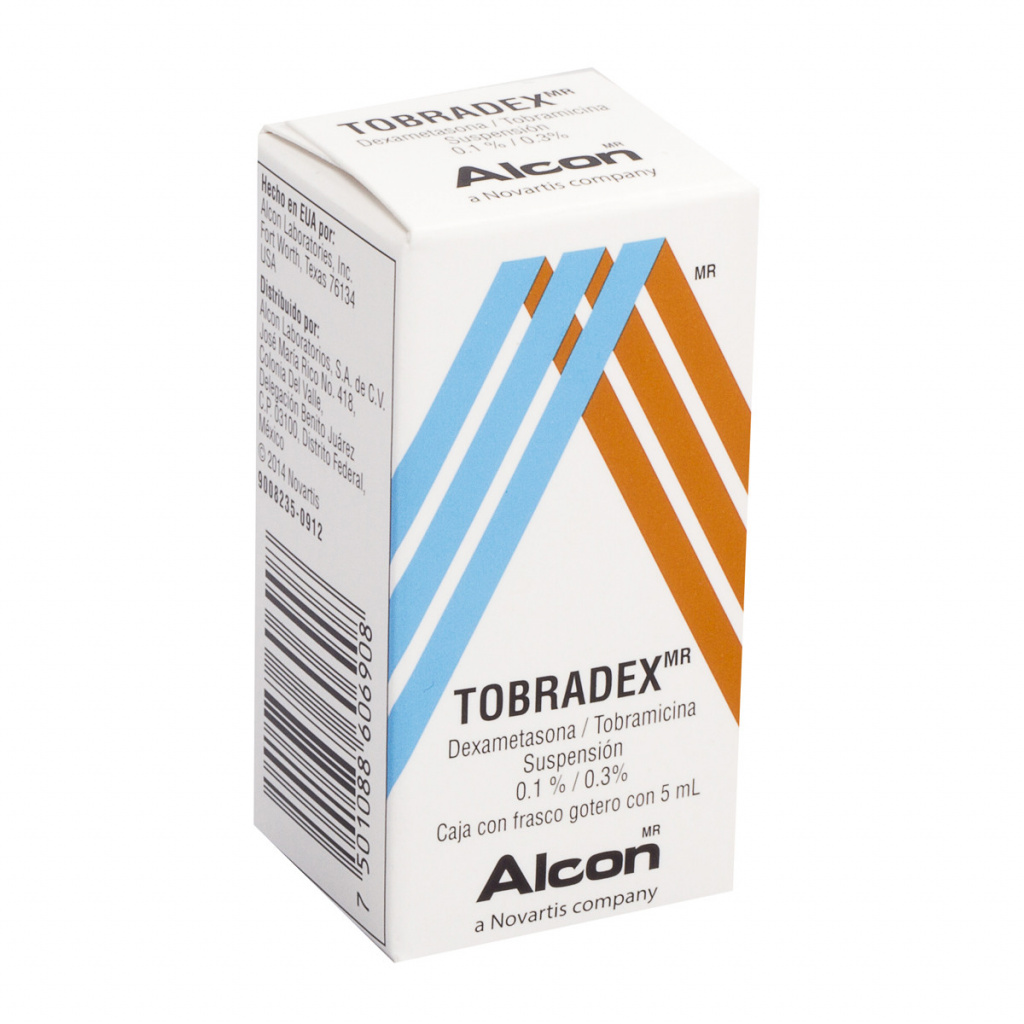
Thoradex also applies to combination drugs. It combines a fairly strong antibiotic tobramycin and the same synthetic hormone of the adrenal cortex - dexamethasone. At the same time, tobramycin has, perhaps, even greater strength than separately neomycin or polymyxin B, which are part of the previous drug. Tobramycin is also active against penicillin-insensitive strains. These are hemolytic streptococci, Escherichia, Proteus, Hemophilus bacillus, and even some types of Neisseria.
As for dexamethasone, it, as in the previous case, reduces swelling and exudation, reduces the symptoms of inflammation, eliminates the allergic component and contributes to a smoother course in the postoperative period. This effective combination also significantly reduces the risk of an infectious process. In addition to the prevention of postoperative complications, Tobradex is indicated for keratitis, blepharitis and conjunctivitis, but again, only bacterial, and not viral etiology.
It is necessary to bury the drug in one to two drops every 6 hours, this is enough for prevention. Toradex is released by the same company Alcon, the cost of the drug is not much different from the previous one. A 5 ml vial costs, on average, 450 rubles.
Advantages and disadvantages
Like Maxitrol, Tauradex is a combined anti-inflammatory and antibacterial drug, and they are included in the same price segment. As in the previous case, the drug is indicated for both prevention and treatment, but only under the conditions of the absence of a viral, tuberculosis and fungal process.Tobradex can cause side effects, especially if it is applied too often. This may be an increase in intraocular pressure, as well as slowing the healing process of wounds. This may be due to a pronounced anti-inflammatory effect of dexamethasone. But if applied correctly, in a short course, and for the purpose of prevention, it reliably protects the eye after surgery for the removal of cataracts.
Attention! This rating is subjective, is not advertising and does not serve as a guide to the purchase. Before buying, you should consult with a specialist.





